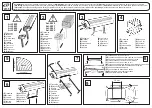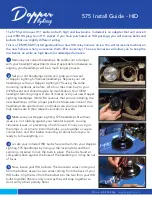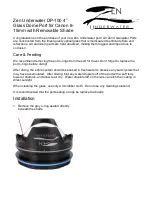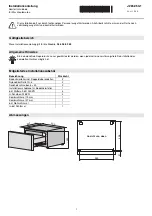
Power Capacitor
1 Applications
The power capacitor serves for stabilizing the supply volt-
age for high power amplifiers in an individual 12 V mains
with rechargeable battery to improve the music repro-
duction.
2 Safety Notes
The capacitor corresponds to the directive 89 / 336 / CEE
for electromagnetic compatibility.
●
Connection of the capacitor to the 12 V mains must
be made by qualified skilled personnel only. Special
care must be taken when connecting the capacitor. In
case of short circuits there may be dangerously high
currents.
●
The capacitor must be mounted to a mechanically
stable place. It must be skilfully fixed so that it does not
get loose and turn into a dangerous projectile.
●
Protect the capacitor against humidity and heat (admis-
sible ambient temperature range –20 °C to +60 °C).
●
For cleaning only use a dry, soft cloth, by no means che-
micals or water.
●
If the capacitor is used for purposes other than originally
intended, if it is not connected correctly or not repaired in
an expert way, no liability can be taken over for possible
damage.
●
If the capacitor is to be put out of operation definitively,
it must be disposed of in a local recycling plant for dis-
posal which is not harmful to the environment.
3 Mounting and Connection
The cables between the capacitor and the power amplifier
should be as short as possible and show a large cross
section*. Lay the cables so that their insulation may not be
damaged.
1) Tightly screw the capacitor with the supplied brackets
as close as possible to the power amplifier at a
mechanically stable place.
2) The connection is shown in fig. 2. Connect the nega-
tive terminal of the capacitor via a cable to the ground
of the 12 V mains. To avoid a ground loop, choose the
same place at which also the power amplifier is
connected to ground.
3) Connect a cable with a sufficient cross section* to the
positive pole of the battery.
After the charging which takes some seconds, connect
the positive cable of the battery directly to the positive
terminal of the capacitor. Lay another cable from the
positive terminal of the capacitor to the supply voltage
connection of the power amplifier.
4 Indicating Elements (fig. 1)
1 The LEDs light up blue if the capacitor is charged or
discharged.
2 The digital voltmeter shows the applied voltage (3 digits,
with one digit after the point).
3 The buzzer sounds if the positive and negative termi-
nals at the capacitor have been mixed up.
➪
Connect the capacitor correctly.
Warning! Never connect the terminals in the opposite
way out of curiosity. The resulting short circuit current
will be dangerously high!
5 Specifications
Capacitance: . . . . . . . . . . 2.0 F
Max. operating voltage: . . 16 V
Dimensions: . . . . . . . . . . . Ø 90 mm x 270 mm
Weight: . . . . . . . . . . . . . . . 1800 g
According to the manufacturer. Subject to change.
*
see mounting instructions for the amplifier
Important!
Always insert a fuse* close to the battery as a pro-
tection against short circuits (see fig. 2).
For the first charging, connect in any case the posi-
tive cable of the battery and the positive pole of the
capacitor via the supplied incandescent lamp to avoid
damage due to excessive current peaks.
Power-Kondensator
1 Verwendungsmöglichkeiten
Der Power-Kondensator dient in eigenständigen 12-V-
Netzen mit Batterie (Akkumulator) zur Stabilisierung der
Versorgungsspannung für Hochleistungsendstufen, um
die Musikwiedergabe zu verbessern.
2 Sicherheitshinweise
Der Kondensator entspricht der Richtlinie 89/336/EWG
für elektromagnetische Verträglichkeit.
●
Der Anschluss des Kondensators an das 12-V-Netz darf
nur durch qualifiziertes Fachpersonal erfolgen. Dabei
ist besondere Sorgfalt geboten. Bei Kurzschlüssen kön-
nen gefährlich hohe Ströme fließen.
●
Der Kondensator muss fest und fachgerecht an einer
mechanisch stabilen Stelle montiert werden, damit er
sich nicht löst und zu einem gefährlichen Geschoss
wird.
●
Schützen Sie den Kondensator vor Feuchtigkeit und
Hitze (zulässiger Einsatztemperaturbereich -20 °C bis
+60 °C).
●
Für die Reinigung nur ein weiches, trockenes Tuch ver-
wenden, auf keinen Fall Chemikalien oder Wasser.
●
Wird der Kondensator zweckentfremdet, nicht richtig an-
geschlossen oder nicht fachgerecht repariert, kann für
eventuelle Schäden keine Haftung übernommen werden.
●
Soll der Kondensator endgültig aus dem Betrieb ge-
nommen werden, übergeben Sie ihn zur umweltgerech-
ten Entsorgung einem örtlichen Recyclingbetrieb.
3 Montage und Anschluss
Die Kabel zwischen dem Kondensator und der Endstufe
sollten möglichst kurz sein und einen großen Querschnitt*
aufweisen. Die Kabel so verlegen, dass deren Isolierung
nicht beschädigt werden kann.
1) Den Kondensator möglichst nahe der Endstufe mit den
beiliegenden Haltern an einer mechanisch stabilen
Stelle fest anschrauben.
2) Der Anschluss ist in Abb. 2 dargestellt. Die Minusklem-
me des Kondensators über ein Kabel mit der Masse
des 12-V-Netzes verbinden. Zur Vermeidung einer
Masseschleife die gleiche Stelle wählen, an der auch
die Endstufe an Masse liegt.
3) An den Pluspol der Batterie ein Kabel mit ausreichend
großem Querschnitt* anschließen.
Nach dem Aufladevorgang von einigen Sekunden das
Pluskabel der Batterie direkt an die Plusklemme des
Kondensators anschließen. Von der Plusklemme des
Kondensators ein weiteres Kabel zum Versorgungs-
spannungsanschluss der Endstufe führen.
4 Anzeigeelemente (Abb. 1)
1 LEDs leuchten blau, wenn der Kondensator geladen
oder entladen wird.
2 Digital-Voltmeter zeigt die anliegende Spannung an
(3-stellig, mit einer Nachkommastelle).
3 Summer ertönt, wenn die Plus- und Minusklemmen am
Kondensator vertauscht wurden.
➪
Kondensator richtig anschließen.
Warnung! Auf keinen Fall interessehalber die Klem-
men vertauscht anschließen. Es fließt dabei ein ge-
fährlich hoher Kurzschlußstrom!
5 Technische Daten
Kapazität: . . . . . . . . . . . . . 2,0 F
Max. Betriebsspannung: . 16 V
Abmessungen: . . . . . . . . . Ø 90 mm x 270 mm
Gewicht: . . . . . . . . . . . . . . 1800 g
Laut Angaben des Herstellers. Änderungen vorbehalten.
* siehe Montageanleitung für die Endstufe
Wichtig!
Zum Schutz gegen Kurzschlüsse unbedingt eine
Sicherung* in Nähe der Batterie zwischenschalten
(siehe Abb. 2).
Beim ersten Aufladen das Pluskabel der Batterie und
den Pluspol des Kondensators unbedingt über die
beiliegende Glühlampe verbinden, um Beschädigung
durch zu hohe Stromspitzen zu vermeiden.
2
1
➀
POWER
GROUND BATTERY REMOTE
SPEAKER OUTPUT
R
F
Masse
ground
Sicherung
fuse
Batterie
battery
Masse
ground
CAP-20
Endstufe
power amplifier
max.
20 cm
!
➁
Copyright
©
by MONACOR
®
INTERNATIONAL GmbH & Co. KG, Bremen, Germany. All rights reserved.
A-0004.99.03.07.2002
®
1
3
HIGH CAPACITY
POWER CAPACITOR
CAP-20
Best.-Nr. 14.2110
D
A
CH
GB




















